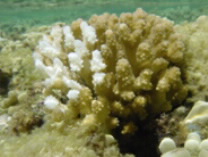FOR IMMEDIATE RELEASE
ACS News Service Weekly PressPac: December 02, 2009
Discovery of the Jekyll-and-Hyde factors in "coral bleaching"
“NMR-Based Microbial Metabolomics and the Temperature-Dependent Coral Pathogen Vibrio coralliilyticu”
Environmental Science & Technology
Scientists are reporting the first identification of substances involved in the Jekyll-and-Hyde transformation that changes harmless marine bacteria into killers that cause “coral bleaching.” Their study appears in ACS’ Environmental Science & Technology, a semi-monthly journal: “NMR-Based Microbial Metabolomics and the Temperature-Dependent Coral Pathogen Vibrio coralliilyticu.”
Dan Bearden and colleagues note that bleaching already has destroyed up to 30 percent of the world’s coral reefs, and scientists are searching for ways to slow or stop the damage. One known culprit is an ocean-dwelling bacterium, Vibrio coralliilyticus (V. coralliilyticus) that chokes-off corals’ energy supply and kills these shell-clad marine animals. At lower temperatures, the bacteria are harmless to coral. But at warmer temperatures (above 75 degrees Fahrenheit) the bacteria become virulent and can kill coral.
The new study reports identification of three chemicals — betaine, glutamate, and succinate — that V. coralliilyticus produces in warmer water and are involved in the transformation. The discovery opens the door to understanding the biology involved in the complex interactions between corals and bacteria and unraveling the mystery of coral bleaching, the scientists indicated.
![]()
Contact
Science Inquiries: Michael Woods, Editor, 202-872-6293
General Inquiries: Michael Bernstein, 202-872-6042

of bleaching. Scientists are reporting
progress toward understanding how this
harmful process occurs.
Credit: National Oceanographic and
Atmospheric Administration
(High-resolution version)

